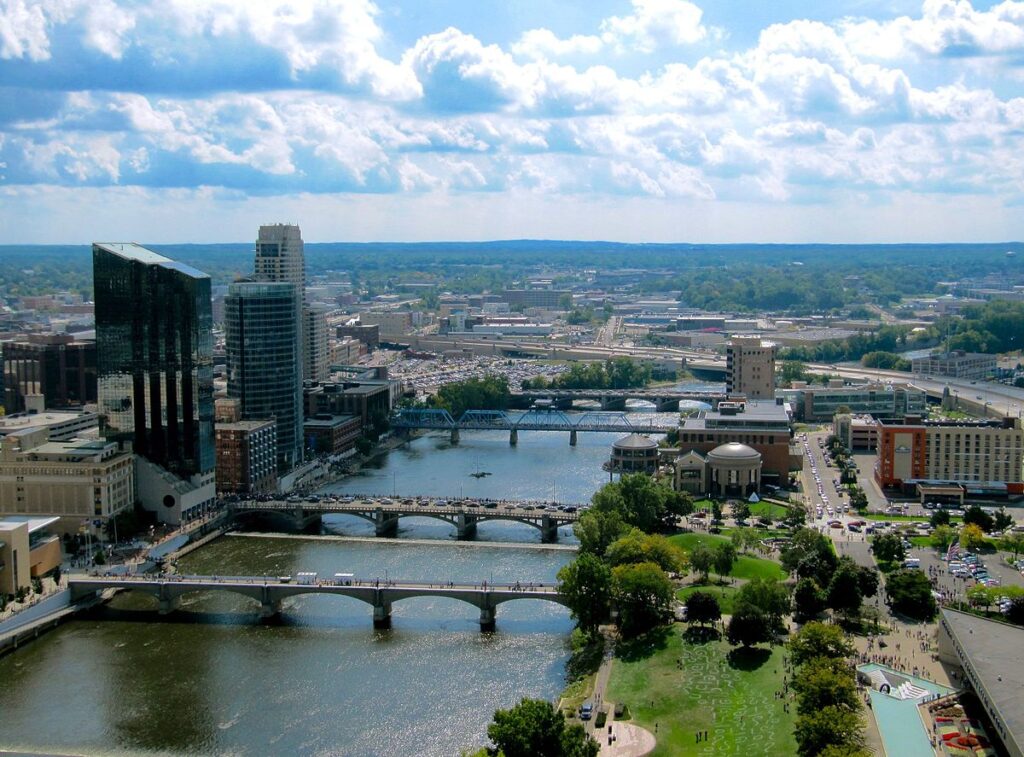
Moving to Grand Rapids, Michigan: A Comprehensive Relocation Guide
Considering moving to Grand Rapids, Michigan? This thriving city offers craft beer culture, furniture heritage, and exceptional livability. With approximately 201,000 residents in 2025 (metro 1.1 million+), Grand Rapids combines beer city excellence with cultural richness and West Michigan’s dynamic destination.
Demographic Profile to Consider If Moving to Grand Rapids:
Grand Rapids’ 2025 population is approximately 201,000 residents, making it Michigan’s second-largest city, with the metro exceeding 1.1 million. The median age is around 33 years, with young professionals, families, diverse residents, and college students. The population is approximately 64% White, 20% Hispanic, 19% Black or African American, 2% Asian. Grand Rapids features vibrant downtown with craft breweries, furniture manufacturing heritage (office furniture capital), growing tech sector, and serves as West Michigan’s economic and cultural hub. The city attracts young professionals seeking Midwest affordability with urban culture, craft beer enthusiasts, furniture industry workers, diverse families, and those wanting West Michigan quality of life. Grand Rapids appeals to those valuing craft beer culture, affordability, entrepreneurship, and Midwest livability. The community balances Dutch Reformed heritage with growing diversity, furniture legacy with tech growth, and maintaining livable character. Find trusted local services for moving, living, and working in Grand Rapids.Grand Rapids Relocation Directory
Cost of Living to Consider If Moving to Grand Rapids:
Grand Rapids offers exceptional affordability. Median home values range from $180,000 to $280,000 in 2025, providing tremendous value for the amenities and culture. The median household income is approximately $56,000. Rental properties average $1,000 to $1,500 monthly. Michigan has flat income tax 4.25%. Property taxes are moderate. Overall cost of living is very competitive for the quality of life, making Grand Rapids highly attractive for young professionals, families, entrepreneurs, and those seeking Midwest urban affordability with culture. The city provides exceptional value with craft beer scene and livability.
Economy and Job Market:
Grand Rapids’ economy includes healthcare, furniture manufacturing, technology, and education. Major employers include Spectrum Health (massive regional healthcare system), Mercy Health, office furniture manufacturers (Steelcase, Herman Miller, Haworth – office furniture capital of America), growing tech sector, Amway (headquarters), and diverse businesses. Healthcare dominates employment. Furniture industry remains significant. Tech sector growing. Typical industries include healthcare, furniture manufacturing, technology, and services. Wages reflect Midwest levels though opportunities exist. The job market attracts healthcare professionals, furniture industry workers, tech workers, and diverse professionals seeking West Michigan opportunity.
Education:
Grand Rapids Public Schools serves city students. School quality varies requiring research. Grand Valley State University, Aquinas College, Calvin University, and others provide higher education creating college atmosphere. The educational infrastructure serves the diverse, growing population.
Recreation and Lifestyle:
Grand Rapids offers EXCEPTIONAL CRAFT BEER SCENE earning Beer City USA title multiple times with 80+ breweries including Founders Brewing (nationally renowned), creating unparalleled beer culture for city size. The city features vibrant downtown with restaurants, entertainment, and walkability, ArtPrize (massive international art competition), Grand Rapids Art Museum, Frederik Meijer Gardens & Sculpture Park (world-class), and diverse neighborhoods. Residents enjoy craft beer culture with brewery tours and beer festivals, ArtPrize creating worldwide attention, Meijer Gardens excellence, affordable Midwest urban living, growing food scene, Lake Michigan beaches (30 minutes), and exceptional quality of life. The lifestyle revolves around craft beer culture (defining characteristic), arts and culture appreciation, outdoor recreation access, entrepreneurial energy, and Midwest livability. The four-season Michigan climate features cold winters and pleasant summers with lake effect. The community fiercely values craft beer culture (Beer City USA pride), ArtPrize international recognition, Meijer Gardens, furniture manufacturing heritage, entrepreneurship, Christian (Dutch Reformed) heritage influence, and maintaining livability. Living in Grand Rapids means accepting West Michigan location, conservative Christian heritage influence on culture, cold snowy winters with lake effect, and prioritizing Midwest living while experiencing EXCEPTIONAL CRAFT BEER SCENE among America’s best for city size, ArtPrize international art event, Frederik Meijer Gardens world-class excellence, affordable Midwest urban living, vibrant downtown, growing food culture, Lake Michigan beach proximity, and comprehensive livability consistently ranking among America’s best places to live creating West Michigan’s ultimate destination where Beer City meets art culture and exceptional affordability with livability defines Michigan’s most dynamic mid-sized city.
Healthcare and Services:
Grand Rapids residents access world-class healthcare through Spectrum Health (major regional system), Mercy Health, and comprehensive medical facilities. The healthcare infrastructure is excellent with regional hub status.
Transportation:
Grand Rapids is accessed via Interstate 96, Interstate 196, U.S. Route 131, and various corridors. Gerald R. Ford International Airport provides excellent commercial service. The Rapid operates bus service. Most residents use personal vehicles though downtown offers walkability. Typical travel times to Detroit are 2.5 hours, to Chicago 3 hours.
Conclusion:
Moving to Grand Rapids in 2025 offers exceptional West Michigan living with Beer City culture, ArtPrize excellence, and outstanding livability. The city’s combination of craft beer scene, Meijer Gardens, and exceptional affordability makes it ideal for young professionals, beer enthusiasts, and families seeking Michigan’s most livable destination where Beer City meets art culture and Midwest affordability defines West Michigan’s dynamic hub.

